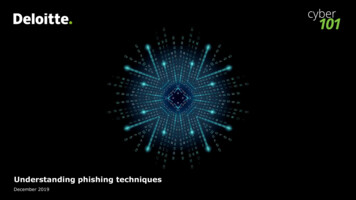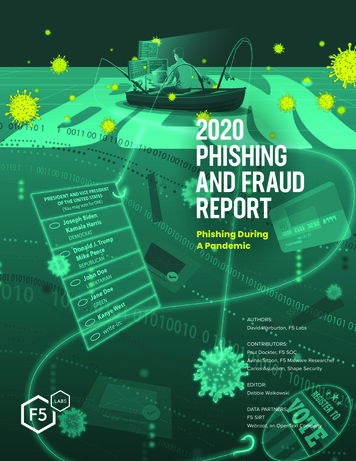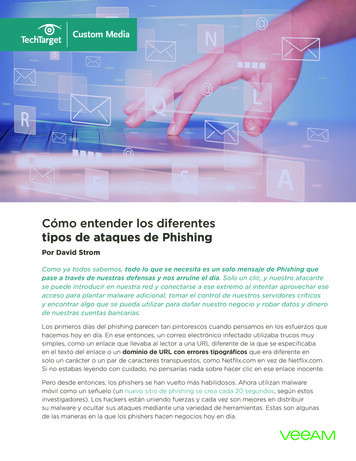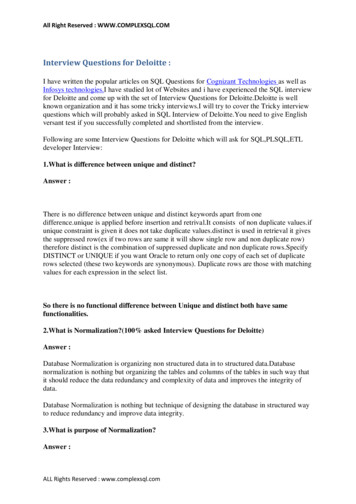
Transcription
Understanding phishing techniquesDecember 2019
Understanding phishing techniquesOverviewPhishing is a type of social engineering attack often used to steal user data, including logincredentials and credit card numbers. This occurs when an attacker pretends to be a trusted entityto dupe a victim into clicking a malicious link, that can lead to the installation of malware, freezingof the system as part of a ransomware attack, or revealing of sensitive information.Phishing is one of the oldest types of cyberattacks,dating back to the 1990s. Despite having been aroundfor decades, it is still one of the most widespread anddamaging cyberattacks.Two key consequences of phishing are:1. Financial loss2. Data loss and legal er-attack-works-and-how-to-prevent-it.html 2019 Deloitte & Touche Enterprise Risk Services Pte LtdCyber 1012
Understanding phishing techniquesCosts of phishing – Financial lossPhishing can lead to devastating financial losses for individuals as well as businesses.For an individual, if a hacker manages to access sensitive bank account information, personal fundsand investments are at risk of being stolen.For businesses, financial losses can extend to regulatory fines and remediation costs. exemplifiedby the figures below: 3.92M90%average total costof a data breachof data breaches arecaused by phishing30%65%of phishing messages getopened by targeted usersincrease in phishingattempts in the past year76%of businesses reportedbeing a victim of aphishing attack 12Blosses caused by businessemail compromise in-2018 2019 Deloitte & Touche Enterprise Risk Services Pte LtdCyber 1013
Understanding phishing techniquesCosts of phishing – Data loss and reputational damagePhishing attacks often attempt to access more than just money from companies and individuals.Instead, they attempt to steal something much more valuable - data.When phishing attacks successfully trigger data breaches, phishers can also cause damage individuals’reputation by: Using the victim’s credentials for illegal activities or to blackmail the victim’s contactsPublishing the victim’s personal information to embarrass themImpersonating the victim to send out fake emails or malicious postsFor businesses, phishing can also lead to data breaches that will impact consumer trust.In Deloitte’s GDPR Benchmark Survey, out of 1,650 consumers who were surveyed:25%Would trust anorganisation less if itsdata was compromised59%Would be less likely tobuy from a companyinvolved in a data /deloitte-uk-risk-gdpr-six-months-on.pdf 2019 Deloitte & Touche Enterprise Risk Services Pte LtdCyber 1014
Understanding phishing techniquesTypes of phishing techniquesAs phishing messages and techniques become increasingly sophisticated, despitegrowing awareness and safety measures taken, many organisations and individualsalike are still falling prey to this pervasive scam.We will delve into the five key phishing techniques that are commonly employed:1) Link manipulation2) Smishing3) Vishing4) Website forgery5) /#gref 2019 Deloitte & Touche Enterprise Risk Services Pte LtdCyber 1015
Understanding phishing techniquesTypes of phishing techniques – Link manipulationLink manipulation is done by directing a user fraudulently to click a link to a fake website. This can be done throughmany different channels, including emails, text messages and social media.1. Use of sub-domains2. Hidden URLsThe URL hierarchy always goes from right to left. If you are accessingYahoo Mail, the correct link should be mail.yahoo.com – whereYahoo is the main domain, and Mail is the sub-domain.This is when a phisher hides the actual URL of a phishing websiteunder plain text, such as “Click Here” or “Subscribe”.A phisher may try to trick you with the fraudulent link yahoo.mail.comwhich will lead you to a page with a main domain of Mail and a subdomain of Yahoo.3. Misspelled URLsWhen a hacker buys domains with a variation in spellings of apopular domain, such as facebok.com, googlle.com, yahooo.com.This technique is also known as URL hijacking or typosquatting.A more convincing scam could even display a legitimate URL thatactually leads to an unexpected website.4. IDN homograph attacksIn this technique, a malicious individual misguides a user towards alink by taking advantage of similar looking ques/#gref 2019 Deloitte & Touche Enterprise Risk Services Pte LtdCyber 1016
Understanding phishing techniquesTypes of phishing techniques – SmishingSmishing is a form of phishing where someone tries to trick a victim into giving their private information via a textmessage.The most common form of smishing is a text with a link that automatically downloads malware. An installed piece ofmalware can steal personal data such as banking credentials, tracking locations, or phone numbers from contact lists tospread the virus in hopes to exponentially multiply.Another smishing tactic is to pose as a legitimate and well-known institution to solicit personal information from victims.In some cases, scammers masquerade as tax authorities to get users’ financial information and use that to steal /smishing-threat-targets-phones-by-text-message/ 2019 Deloitte & Touche Enterprise Risk Services Pte LtdCyber 1017
Understanding phishing techniquesTypes of phishing techniques – VishingVishing is the telephone version of phishing, or a voice scam. Similar to email phishing and smishing, vishing isdesigned to trick victims into sharing personal information, such as PIN numbers, social security numbers, credit cardsecurity codes, passwords and other personal data.Vishing calls often appear to be coming from an official source such as a bank or a government organisation. Thesevishers even create fake Caller ID profiles (called ‘Caller ID spoofing’) which makes the phone numbers seem legitimate.Recently, vishers are even able to impersonate people through mimicking voices using artificial intelligence and trickvictims into transferring money to them.Criminals used artificial intelligencebased software to impersonate achief executive’s voice and demanda fraudulent transfer of 220,000(US 243,000).(Click to read nternational.com/vishing/what-is-vishing/ 2019 Deloitte & Touche Enterprise Risk Services Pte LtdCyber 1018
Understanding phishing techniquesTypes of phishing techniques – Website forgeryWebsite forgery works by making a malicious website impersonate an authentic one, so as to make the visitors give uptheir sensitive information such as account details, passwords, credit card numbers.Web forgery is mainly carried out in two ways: cross-site scripting and website spoofing.Cross-Site ScriptingWebsite spoofingThis is when a hacker executes malicious script or payload intoa legitimate web application or website through exploiting avulnerability.This is done by creating a fake website that looks similar to alegitimate website that the user intends to access.1Attacker sends script-injectedlink to victim (e.g. email scam)2Malicious script sendsvictim’s private datato attackerVictim clicks onlink and requestslegitimate website43Victim’s browser loadslegitimate site, but alsoexecutes malicious threats/cross-site-scripting/ 2019 Deloitte & Touche Enterprise Risk Services Pte LtdCyber 1019
Understanding phishing techniquesTypes of phishing techniques – Pop-upsPop-up messages, other than being intrusive, are one of the easiest techniques to conduct phishing scams.They allow hackers to steal login details by sending users pop-up messages and eventually leading them to forgedwebsites.In-session phishing“Pop-up tech support”This variant of phishing works by displaying a pop-up windowduring an online banking session, asking the user to retype hisusername and password as the session has expired.Another widespread pop-up phishing scam is the “popuptech support.”The user enters his details, not expecting the pop-up to be afraud as they had already logged into the bank’s website.When browsing the Internet, you will suddenly receive apop-up message that your system is infected and you needto contact your vendor for technical s/#gref 2019 Deloitte & Touche Enterprise Risk Services Pte LtdCyber 10110
Understanding phishing techniquesCase studiesEthereum Classic, 2017Google Docs, 2017Several people lost thousands of dollars incryptocurrency after the Ethereum Classicwebsite was hacked in 2017.In May, more than 3 million workers worldwidewere forced to stop work when phishers sent outfraudulent email invitations on Google docsinviting recipients to edit documents.Using social engineering, hackers impersonatedthe owner of Classic Ether Wallet, gained accessto the domain registry, and then redirected thedomain to their own server where they extractedEthereum cryptocurrency from victims.When the recipients opened the invitations, theywere taken to a third-party app, which enabledhackers to access individuals’ Gmail ss.htmlhttps://www.bbc.com/news/business-39798022 2019 Deloitte & Touche Enterprise Risk Services Pte LtdCyber 10111
Understanding phishing techniquesHow to spot phishing1. Mismatched and misleading informationPay attention to the domains/sub-domains, misspellings, and similar looking characters in URLs. To checkfor hidden URLs, hover your mouse cursor over a suspicious link to see the actual URL.2. Use of urgent or threatening languageBe wary of phrases such as “urgent action required” or “your account will be terminated”, as phishersoften aim to instil panic and fear to trick you into providing confidential information.3. Promises of attractive rewardsFalse offers of amazing deals or unbelievable prizes are commonly used to instil a sense of urgency toprovide your confidential information. If it is too good to be true, it probably is.4. Requests for confidential informationMost legitimate organisations would never ask for your personal information such as login credentials,credit card details and NRIC. When in doubt, contact the company directly to clarify.5. Unexpected emailsIf you receive an email regarding a purchase you did not make, do not open the attachments and links.6. Suspicious attachmentsExercise caution and look out for suspicious attachment names and file types. Be extra wary of .exe files,and delete them immediately if they appear unexpectedly in your for-me/homeinternetusers/spot-signs-of-phishing 2019 Deloitte & Touche Enterprise Risk Services Pte LtdCyber 10112
Understanding phishing techniquesProtect yourself from phishing – General principlesBe cautious of allcommunications. Do notrespond to phishing attempts –report them immediately.Beware of pop-ups. Legitimateorganisations do not ask forpersonal information via pop-upscreens.Do not click on phishing links.If an email looks suspicious,don’t click any links in it anddon’t open its attachments.Install a phishing filter. Whileit won’t keep out all phishingmessages, it will reduce thenumber of ect-yourself-from-phishing-scams/ 2019 Deloitte & Touche Enterprise Risk Services Pte LtdCyber 10113
Deloitte refers to one or more of Deloitte Touche Tohmatsu Limited (“DTTL”), its global network of member firms, and their related entities. DTTL (also referred to as“Deloitte Global”) and each of its member firms and their affiliated entities are legally separate and independent entities. DTTL does not provide services to clients.Please see www.deloitte.com/about to learn more.Deloitte is a leading global provider of audit and assurance, consulting, financial advisory, risk advisory, tax & legal and related services. Our global network ofmember firms and related entities in more than 150 countries and territories (collectively, the “Deloitte organisation”) serves four out of five Fortune Global 500 companies. Learn how Deloitte’s approximately 312,000 people make an impact that matters at www.deloitte.com.Deloitte Asia Pacific Limited is a company limited by guarantee and a member firm of DTTL. Members of Deloitte Asia Pacific Limited and their related entities, each ofwhich are separate and independent legal entities, provide services from more than 100 cities across the region, including Auckland, Bangkok, Beijing, Hanoi, Ho ChiMinh City, Hong Kong, Jakarta, Kuala Lumpur, Manila, Melbourne, Osaka, Shanghai, Singapore, Sydney, Taipei, Tokyo and Yangon.About Deloitte SingaporeIn Singapore, services are provided by Deloitte & Touche LLP and its subsidiaries and affiliates.This communication contains general information only, and none of Deloitte Touche Tohmatsu Limited, its member firms, or their related entities (collectively, the“Deloitte Network”) is, by means of this communication, rendering professional advice or services. Before making any decision or taking any action that may affectyour finances or your business, you should consult a qualified professional adviser. No entity in the Deloitte Network shall be responsible for any loss whatsoeversustained by any person who relies on this communication. 2019 Deloitte & Touche Enterprise Risk Services Pte Ltd
Understanding phishing techniques As phishing messages and techniques become increasingly sophisticated, despite growing awareness and safety measures taken, many organisations and individuals alike are still falling prey to this pervasive scam. We will delve into the five key phishing techniques










